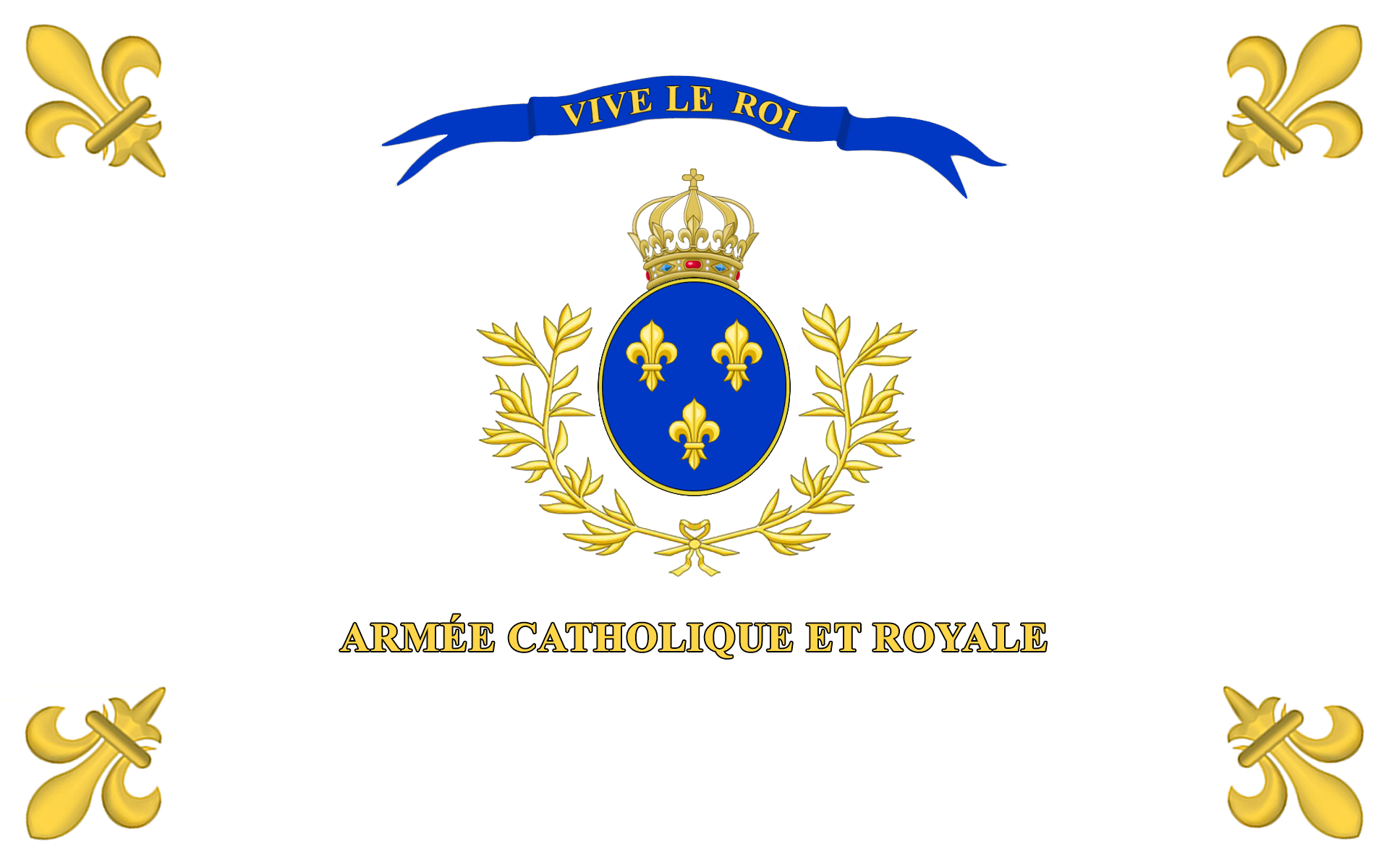Armée catholique et royale
| Catholic and Royal Army of Vendée | |
|---|---|

Type of Catholic and Royal Army of Vendée flag
|
|
| Active | 1793–1800 |
| Country | France, Poitou, Anjou, Brittany: Vendée, northern Deux-Sèvres, southern Maine-et-Loire, southern Loire-Atlantique |
| Allegiance |
|
| Branch | • Catholic and Royal Army of Anjou and of Haut-Poitou • Catholic and Royal Army of Centre • Catholic and Royal Army of Bas-Poitou |
| Size | 80,000 men |
| Motto(s) |
Pour Dieu et le Roi (For God and the King) |
| Colors | White cockade |
| Engagements | War in the Vendée |
| Commanders | |
| Notable commanders |
• Jacques Cathelineau • Louis d'Elbée • Henri de La Rochejaquelein • François de Charette • Jean-Nicolas Stofflet |
| Insignia | |
| Identification symbol |
|
| Catholic and Royal Army of Brittany | |
|---|---|

Chouan emblem
|
|
| Active | 1794–1800 |
| Country | France, Brittany |
| Allegiance |
|
| Branch | • Army of Morbihan •Army of Rennes and Fougères •Army of Maine, Anjou and Haute-Bretagne •Army of the Côtes du Nord |
| Type | Chouan |
| Size | 30,000 to 40,000 men |
| Motto(s) |
In Sapientia Robur, Sic Reflorescent (Strength is in patience, the Lys will flower again) |
| Colors | White cockade |
| Engagements |
Chouannerie Quiberon expedition |
| Commanders | |
| Notable commanders |
• Joseph de Puisaye • René Augustin de Chalus • Jean de Béhague de Villeneuve • Georges Cadoudal |
| Insignia | |
| Identification symbol |
|
| Catholic and Royal Army of Normandy | |
|---|---|
| Active | 1795–1800 |
| Country | France Normandy and Maine: Orne, southern Manche, northern Mayenne |
| Allegiance |
|
| Type | Chouan |
| Size | 5,000 to 10,000 men |
| Engagements | Chouannerie |
| Commanders | |
| Notable commanders |
•Louis de Frotté |
The Catholic and Royal Armies (in French : Armées catholique et royale) is the name given to the royalist armies in western France composed of insurgents during the war in the Vendée and the Chouannerie, who opposed the French revolution, hence they were counterrevolutionary by definition. They were also known as the "Red Army" on account of their emblem: the Sacred Heart
The Catholic and Royal Army of Vendée was composed of the three Vendéen armies although that of Lower Poitou joined only occasionally.
During the year 1793, the Vendéen army was distinguished into sub-armies : the army of Charette in the Marais breton, the Catholic and Royal Army of Anjou and of Haut-Poitou, and that of Bas-Poitou and Retz country, south of the Loire. The Chouans of the north of the Loire who joined the Vendéens during the Virée de Galerne were named Catholic and Royal Army of Bas-Anjou and of Haute-Bretagne.
In reality, those armies were simply groups of fluctuating insurgents led by a chief who had authority over people following his beliefs. The only units with a quasi-permanent existence and organization are the "compagnies de paroisse" which grouped together members of the rural community who elected their captains. Although two-thirds of the insurgents were peasants, they only represented half of the men in these units, the rest being artisans and shopkeepers.
The flaws of this army were its few health services and its lack of permanent fighters, even considering their reinforcements of republican deserters, gabelous, Germans or Swiss. Their weaponry and provisions were also poor. The cavalry was only composed of noble chiefs, a few game wardens and peasants mounted on farm horses. The artillery was composed only of old culverin taken from castles and a few cannons taken from the republicans, making it impossible for the Catholic and Royal Army to oppose a strong Republican army on open field, or to break the fortifications of a town like at Granville.
...
Wikipedia
